Detailed Report on Management Accounting for Tech (UK) Limited
VerifiedAdded on 2024/05/31
|23
|5759
|427
Report
AI Summary
This report provides a comprehensive analysis of management accounting techniques within the context of Tech (UK) Limited, a manufacturer of mobile chargers and gadgets. It differentiates between management and financial accounting, highlighting the importance of management accounting in business decision-making. The report explores cost accounting systems, inventory management, and job costing, alongside various management accounting reports like budgets, sales reports, production reports, and variance analysis. It further examines absorption and marginal costing methods, providing calculations and income statements for Tech (UK) Limited. The document also discusses budgeting processes, pricing strategies, and the role of budgets in planning and control, concluding with an explanation of the Balanced Scorecard approach and its implementation for performance measurement. Desklib provides access to this and many other solved assignments for students.
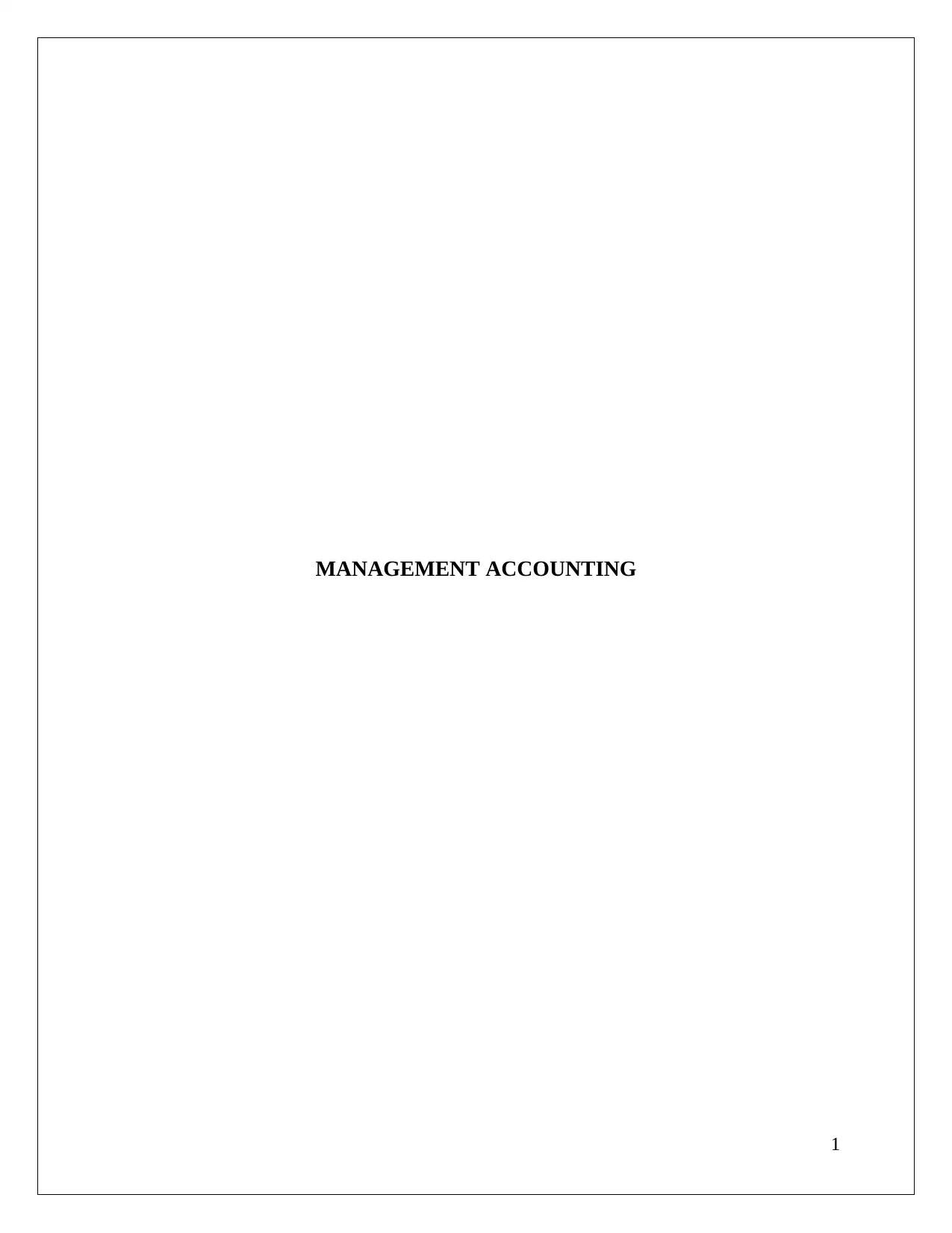
MANAGEMENT ACCOUNTING
1
1
Paraphrase This Document
Need a fresh take? Get an instant paraphrase of this document with our AI Paraphraser
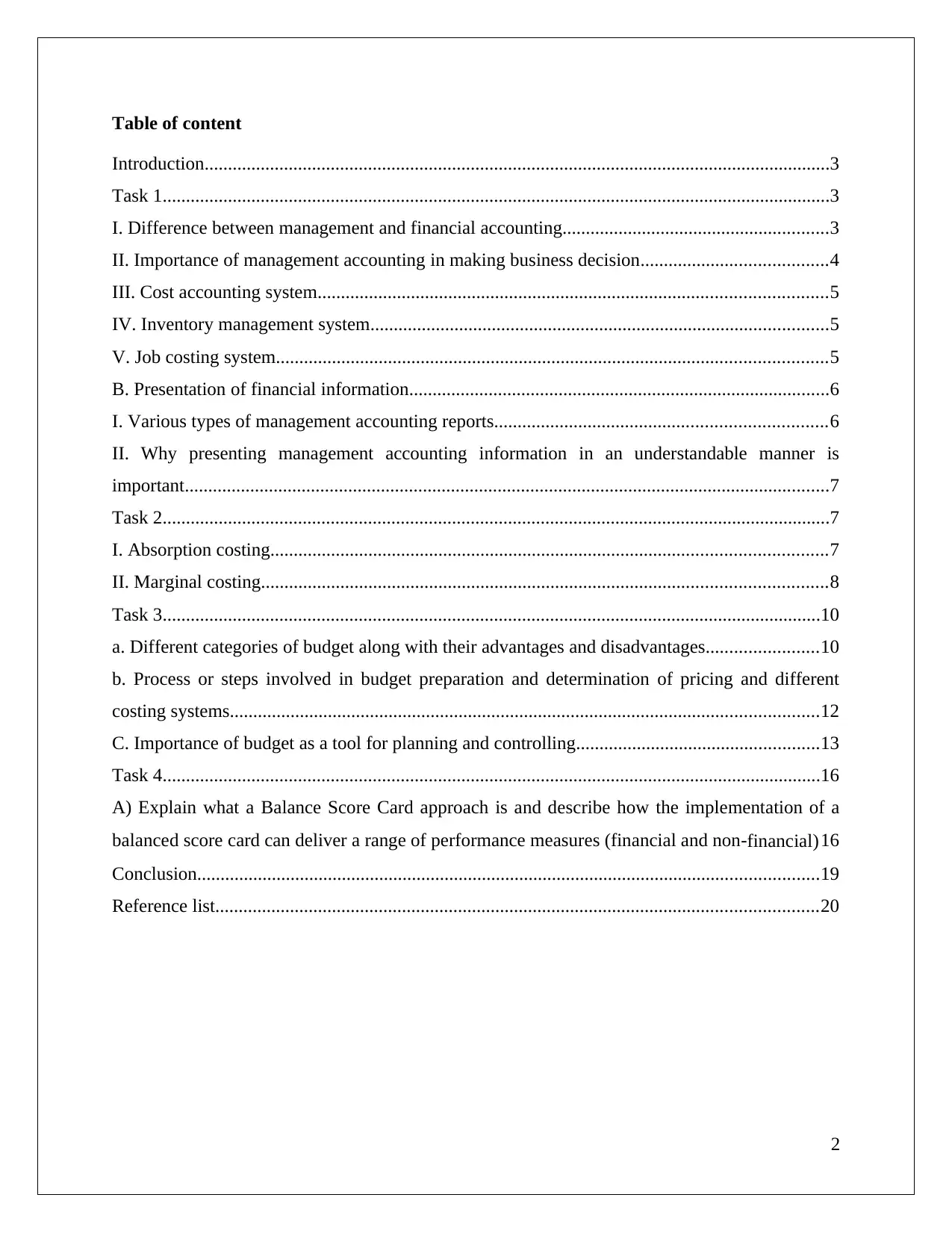
Table of content
Introduction......................................................................................................................................3
Task 1...............................................................................................................................................3
I. Difference between management and financial accounting.........................................................3
II. Importance of management accounting in making business decision........................................4
III. Cost accounting system.............................................................................................................5
IV. Inventory management system..................................................................................................5
V. Job costing system......................................................................................................................5
B. Presentation of financial information..........................................................................................6
I. Various types of management accounting reports.......................................................................6
II. Why presenting management accounting information in an understandable manner is
important..........................................................................................................................................7
Task 2...............................................................................................................................................7
I. Absorption costing.......................................................................................................................7
II. Marginal costing.........................................................................................................................8
Task 3.............................................................................................................................................10
a. Different categories of budget along with their advantages and disadvantages........................10
b. Process or steps involved in budget preparation and determination of pricing and different
costing systems..............................................................................................................................12
C. Importance of budget as a tool for planning and controlling....................................................13
Task 4.............................................................................................................................................16
A) Explain what a Balance Score Card approach is and describe how the implementation of a
balanced score card can deliver a range of performance measures (financial and non-financial)16
Conclusion.....................................................................................................................................19
Reference list.................................................................................................................................20
2
Introduction......................................................................................................................................3
Task 1...............................................................................................................................................3
I. Difference between management and financial accounting.........................................................3
II. Importance of management accounting in making business decision........................................4
III. Cost accounting system.............................................................................................................5
IV. Inventory management system..................................................................................................5
V. Job costing system......................................................................................................................5
B. Presentation of financial information..........................................................................................6
I. Various types of management accounting reports.......................................................................6
II. Why presenting management accounting information in an understandable manner is
important..........................................................................................................................................7
Task 2...............................................................................................................................................7
I. Absorption costing.......................................................................................................................7
II. Marginal costing.........................................................................................................................8
Task 3.............................................................................................................................................10
a. Different categories of budget along with their advantages and disadvantages........................10
b. Process or steps involved in budget preparation and determination of pricing and different
costing systems..............................................................................................................................12
C. Importance of budget as a tool for planning and controlling....................................................13
Task 4.............................................................................................................................................16
A) Explain what a Balance Score Card approach is and describe how the implementation of a
balanced score card can deliver a range of performance measures (financial and non-financial)16
Conclusion.....................................................................................................................................19
Reference list.................................................................................................................................20
2
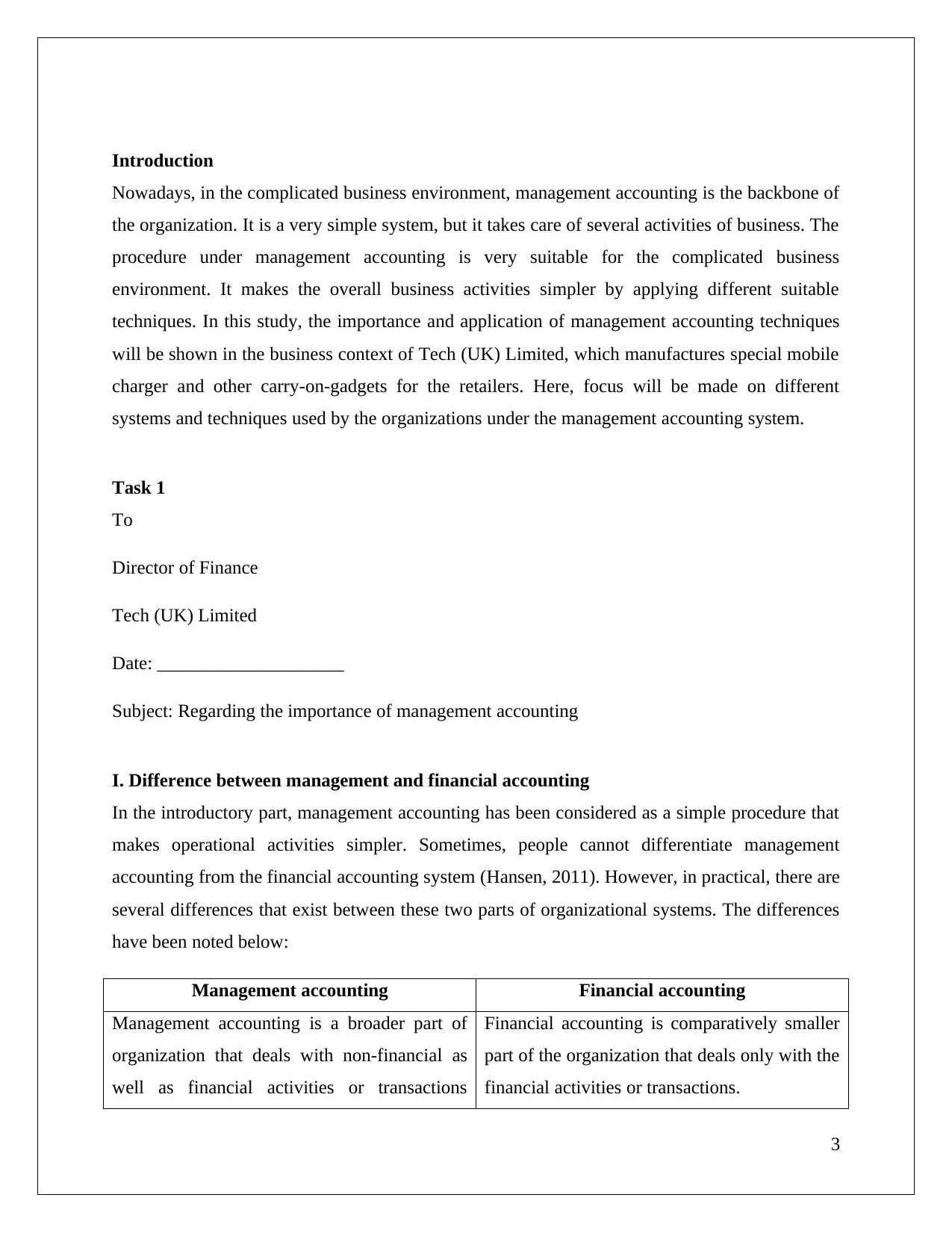
Introduction
Nowadays, in the complicated business environment, management accounting is the backbone of
the organization. It is a very simple system, but it takes care of several activities of business. The
procedure under management accounting is very suitable for the complicated business
environment. It makes the overall business activities simpler by applying different suitable
techniques. In this study, the importance and application of management accounting techniques
will be shown in the business context of Tech (UK) Limited, which manufactures special mobile
charger and other carry-on-gadgets for the retailers. Here, focus will be made on different
systems and techniques used by the organizations under the management accounting system.
Task 1
To
Director of Finance
Tech (UK) Limited
Date: ____________________
Subject: Regarding the importance of management accounting
I. Difference between management and financial accounting
In the introductory part, management accounting has been considered as a simple procedure that
makes operational activities simpler. Sometimes, people cannot differentiate management
accounting from the financial accounting system (Hansen, 2011). However, in practical, there are
several differences that exist between these two parts of organizational systems. The differences
have been noted below:
Management accounting Financial accounting
Management accounting is a broader part of
organization that deals with non-financial as
well as financial activities or transactions
Financial accounting is comparatively smaller
part of the organization that deals only with the
financial activities or transactions.
3
Nowadays, in the complicated business environment, management accounting is the backbone of
the organization. It is a very simple system, but it takes care of several activities of business. The
procedure under management accounting is very suitable for the complicated business
environment. It makes the overall business activities simpler by applying different suitable
techniques. In this study, the importance and application of management accounting techniques
will be shown in the business context of Tech (UK) Limited, which manufactures special mobile
charger and other carry-on-gadgets for the retailers. Here, focus will be made on different
systems and techniques used by the organizations under the management accounting system.
Task 1
To
Director of Finance
Tech (UK) Limited
Date: ____________________
Subject: Regarding the importance of management accounting
I. Difference between management and financial accounting
In the introductory part, management accounting has been considered as a simple procedure that
makes operational activities simpler. Sometimes, people cannot differentiate management
accounting from the financial accounting system (Hansen, 2011). However, in practical, there are
several differences that exist between these two parts of organizational systems. The differences
have been noted below:
Management accounting Financial accounting
Management accounting is a broader part of
organization that deals with non-financial as
well as financial activities or transactions
Financial accounting is comparatively smaller
part of the organization that deals only with the
financial activities or transactions.
3
⊘ This is a preview!⊘
Do you want full access?
Subscribe today to unlock all pages.

Trusted by 1+ million students worldwide
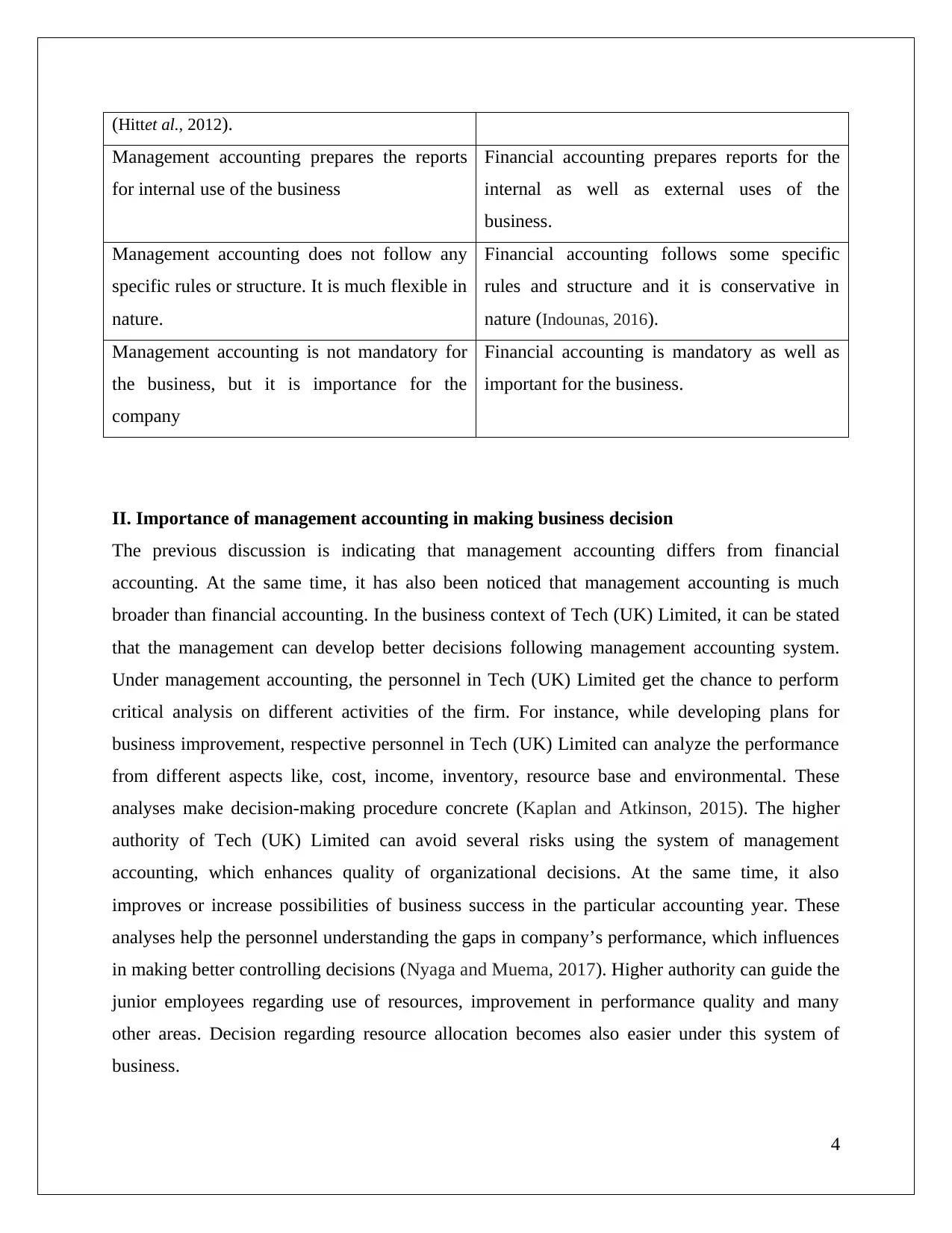
(Hittet al., 2012).
Management accounting prepares the reports
for internal use of the business
Financial accounting prepares reports for the
internal as well as external uses of the
business.
Management accounting does not follow any
specific rules or structure. It is much flexible in
nature.
Financial accounting follows some specific
rules and structure and it is conservative in
nature (Indounas, 2016).
Management accounting is not mandatory for
the business, but it is importance for the
company
Financial accounting is mandatory as well as
important for the business.
II. Importance of management accounting in making business decision
The previous discussion is indicating that management accounting differs from financial
accounting. At the same time, it has also been noticed that management accounting is much
broader than financial accounting. In the business context of Tech (UK) Limited, it can be stated
that the management can develop better decisions following management accounting system.
Under management accounting, the personnel in Tech (UK) Limited get the chance to perform
critical analysis on different activities of the firm. For instance, while developing plans for
business improvement, respective personnel in Tech (UK) Limited can analyze the performance
from different aspects like, cost, income, inventory, resource base and environmental. These
analyses make decision-making procedure concrete (Kaplan and Atkinson, 2015). The higher
authority of Tech (UK) Limited can avoid several risks using the system of management
accounting, which enhances quality of organizational decisions. At the same time, it also
improves or increase possibilities of business success in the particular accounting year. These
analyses help the personnel understanding the gaps in company’s performance, which influences
in making better controlling decisions (Nyaga and Muema, 2017). Higher authority can guide the
junior employees regarding use of resources, improvement in performance quality and many
other areas. Decision regarding resource allocation becomes also easier under this system of
business.
4
Management accounting prepares the reports
for internal use of the business
Financial accounting prepares reports for the
internal as well as external uses of the
business.
Management accounting does not follow any
specific rules or structure. It is much flexible in
nature.
Financial accounting follows some specific
rules and structure and it is conservative in
nature (Indounas, 2016).
Management accounting is not mandatory for
the business, but it is importance for the
company
Financial accounting is mandatory as well as
important for the business.
II. Importance of management accounting in making business decision
The previous discussion is indicating that management accounting differs from financial
accounting. At the same time, it has also been noticed that management accounting is much
broader than financial accounting. In the business context of Tech (UK) Limited, it can be stated
that the management can develop better decisions following management accounting system.
Under management accounting, the personnel in Tech (UK) Limited get the chance to perform
critical analysis on different activities of the firm. For instance, while developing plans for
business improvement, respective personnel in Tech (UK) Limited can analyze the performance
from different aspects like, cost, income, inventory, resource base and environmental. These
analyses make decision-making procedure concrete (Kaplan and Atkinson, 2015). The higher
authority of Tech (UK) Limited can avoid several risks using the system of management
accounting, which enhances quality of organizational decisions. At the same time, it also
improves or increase possibilities of business success in the particular accounting year. These
analyses help the personnel understanding the gaps in company’s performance, which influences
in making better controlling decisions (Nyaga and Muema, 2017). Higher authority can guide the
junior employees regarding use of resources, improvement in performance quality and many
other areas. Decision regarding resource allocation becomes also easier under this system of
business.
4
Paraphrase This Document
Need a fresh take? Get an instant paraphrase of this document with our AI Paraphraser
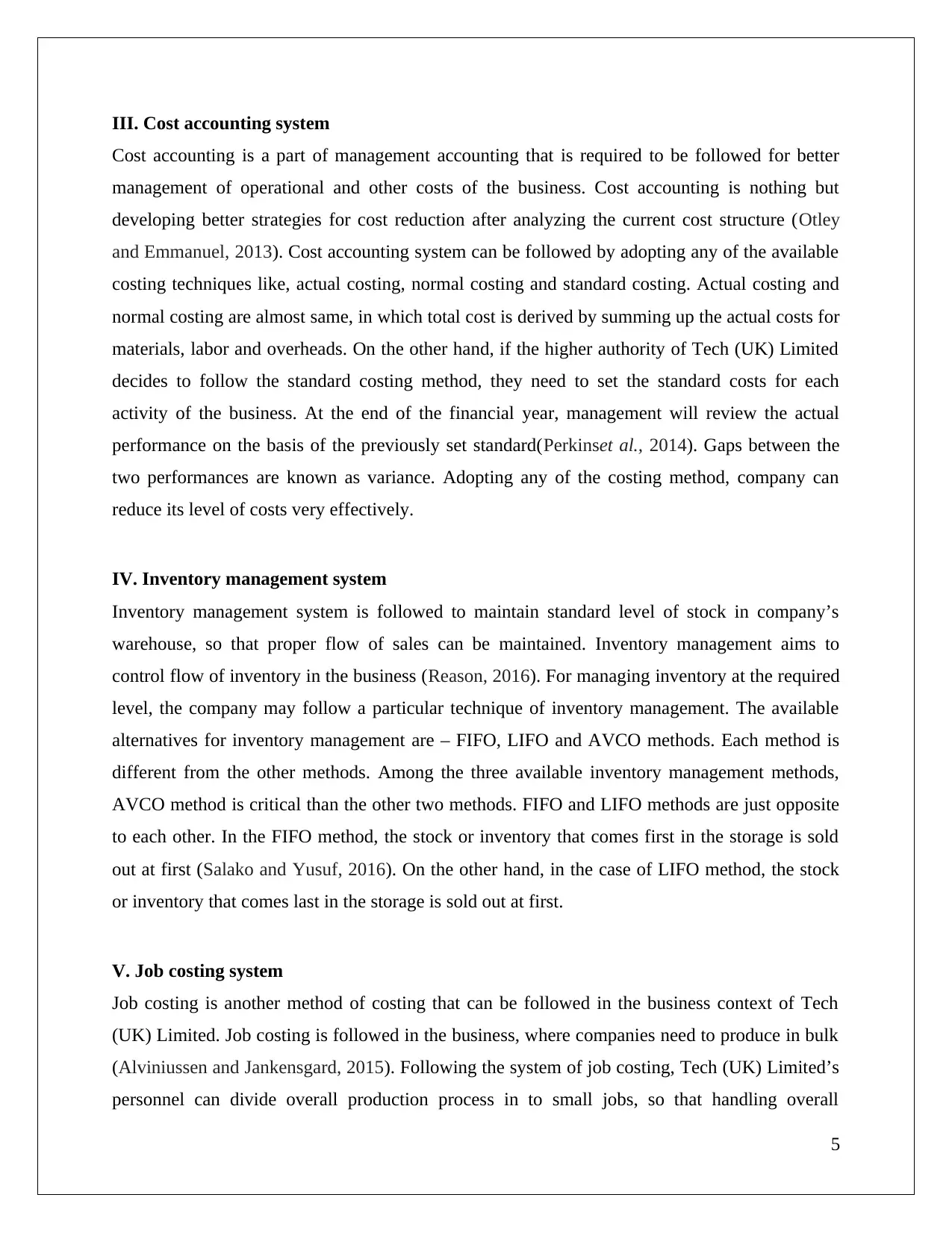
III. Cost accounting system
Cost accounting is a part of management accounting that is required to be followed for better
management of operational and other costs of the business. Cost accounting is nothing but
developing better strategies for cost reduction after analyzing the current cost structure (Otley
and Emmanuel, 2013). Cost accounting system can be followed by adopting any of the available
costing techniques like, actual costing, normal costing and standard costing. Actual costing and
normal costing are almost same, in which total cost is derived by summing up the actual costs for
materials, labor and overheads. On the other hand, if the higher authority of Tech (UK) Limited
decides to follow the standard costing method, they need to set the standard costs for each
activity of the business. At the end of the financial year, management will review the actual
performance on the basis of the previously set standard(Perkinset al., 2014). Gaps between the
two performances are known as variance. Adopting any of the costing method, company can
reduce its level of costs very effectively.
IV. Inventory management system
Inventory management system is followed to maintain standard level of stock in company’s
warehouse, so that proper flow of sales can be maintained. Inventory management aims to
control flow of inventory in the business (Reason, 2016). For managing inventory at the required
level, the company may follow a particular technique of inventory management. The available
alternatives for inventory management are – FIFO, LIFO and AVCO methods. Each method is
different from the other methods. Among the three available inventory management methods,
AVCO method is critical than the other two methods. FIFO and LIFO methods are just opposite
to each other. In the FIFO method, the stock or inventory that comes first in the storage is sold
out at first (Salako and Yusuf, 2016). On the other hand, in the case of LIFO method, the stock
or inventory that comes last in the storage is sold out at first.
V. Job costing system
Job costing is another method of costing that can be followed in the business context of Tech
(UK) Limited. Job costing is followed in the business, where companies need to produce in bulk
(Alviniussen and Jankensgard, 2015). Following the system of job costing, Tech (UK) Limited’s
personnel can divide overall production process in to small jobs, so that handling overall
5
Cost accounting is a part of management accounting that is required to be followed for better
management of operational and other costs of the business. Cost accounting is nothing but
developing better strategies for cost reduction after analyzing the current cost structure (Otley
and Emmanuel, 2013). Cost accounting system can be followed by adopting any of the available
costing techniques like, actual costing, normal costing and standard costing. Actual costing and
normal costing are almost same, in which total cost is derived by summing up the actual costs for
materials, labor and overheads. On the other hand, if the higher authority of Tech (UK) Limited
decides to follow the standard costing method, they need to set the standard costs for each
activity of the business. At the end of the financial year, management will review the actual
performance on the basis of the previously set standard(Perkinset al., 2014). Gaps between the
two performances are known as variance. Adopting any of the costing method, company can
reduce its level of costs very effectively.
IV. Inventory management system
Inventory management system is followed to maintain standard level of stock in company’s
warehouse, so that proper flow of sales can be maintained. Inventory management aims to
control flow of inventory in the business (Reason, 2016). For managing inventory at the required
level, the company may follow a particular technique of inventory management. The available
alternatives for inventory management are – FIFO, LIFO and AVCO methods. Each method is
different from the other methods. Among the three available inventory management methods,
AVCO method is critical than the other two methods. FIFO and LIFO methods are just opposite
to each other. In the FIFO method, the stock or inventory that comes first in the storage is sold
out at first (Salako and Yusuf, 2016). On the other hand, in the case of LIFO method, the stock
or inventory that comes last in the storage is sold out at first.
V. Job costing system
Job costing is another method of costing that can be followed in the business context of Tech
(UK) Limited. Job costing is followed in the business, where companies need to produce in bulk
(Alviniussen and Jankensgard, 2015). Following the system of job costing, Tech (UK) Limited’s
personnel can divide overall production process in to small jobs, so that handling overall
5

production process becomes easier. In this context, it must be noted that job costing helps in
reducing cost level of the firm by eliminating unnecessary costs (Aminbakhsh et al., 2015).
B. Presentation of financial information
I. Various types of management accounting reports
Management accounting controls overall activities of the firm by using different reports. Reports
are prepared for each activity or department. For example, if the case study of Tech (UK)
Limited is considered, it is noticeable that as a manufacturing firm, the business includes several
departments and under management accounting, every department needs to prepare separate
reports. Various types of reports under management accounting system are stated below:
Budgets – Budgets can be considered as the most important management accounting report that
shows plans for the business in the coming years. This report is not only important for systematic
operations of the business, but it is also important for proper allocation of resources
(Belleflamme and Peitz, 2015). Budgets are prepared by analyzing the past and present
performance of the business critically. Along with that analyzing the current resource base of the
business is very important.
Sales report – This report focuses on the value and volume of sales in an organization. It means
the report deals with the sales department of the company. In the sales report, the detailed
information regarding the revenue and direct and indirect costs of the business is available (Binti,
2016). Preparing sales report, the higher authority can easily understand changes in revenue level
of the business.
Production report – Like sales report, production report is prepared including all details of
production of the firm. The production report includes detailed information related to the total
raw materials, labor and overhead costs that have been involved in the production process
(Warrenet al., 2015). The quantity of resources that are used in the production is also included in
the production report of the business.
Inventory report – This is another report that higher authority and the departments at Tech (UK)
Limited are needed to be prepared by considering detailed information regarding the inventory
6
reducing cost level of the firm by eliminating unnecessary costs (Aminbakhsh et al., 2015).
B. Presentation of financial information
I. Various types of management accounting reports
Management accounting controls overall activities of the firm by using different reports. Reports
are prepared for each activity or department. For example, if the case study of Tech (UK)
Limited is considered, it is noticeable that as a manufacturing firm, the business includes several
departments and under management accounting, every department needs to prepare separate
reports. Various types of reports under management accounting system are stated below:
Budgets – Budgets can be considered as the most important management accounting report that
shows plans for the business in the coming years. This report is not only important for systematic
operations of the business, but it is also important for proper allocation of resources
(Belleflamme and Peitz, 2015). Budgets are prepared by analyzing the past and present
performance of the business critically. Along with that analyzing the current resource base of the
business is very important.
Sales report – This report focuses on the value and volume of sales in an organization. It means
the report deals with the sales department of the company. In the sales report, the detailed
information regarding the revenue and direct and indirect costs of the business is available (Binti,
2016). Preparing sales report, the higher authority can easily understand changes in revenue level
of the business.
Production report – Like sales report, production report is prepared including all details of
production of the firm. The production report includes detailed information related to the total
raw materials, labor and overhead costs that have been involved in the production process
(Warrenet al., 2015). The quantity of resources that are used in the production is also included in
the production report of the business.
Inventory report – This is another report that higher authority and the departments at Tech (UK)
Limited are needed to be prepared by considering detailed information regarding the inventory
6
⊘ This is a preview!⊘
Do you want full access?
Subscribe today to unlock all pages.

Trusted by 1+ million students worldwide
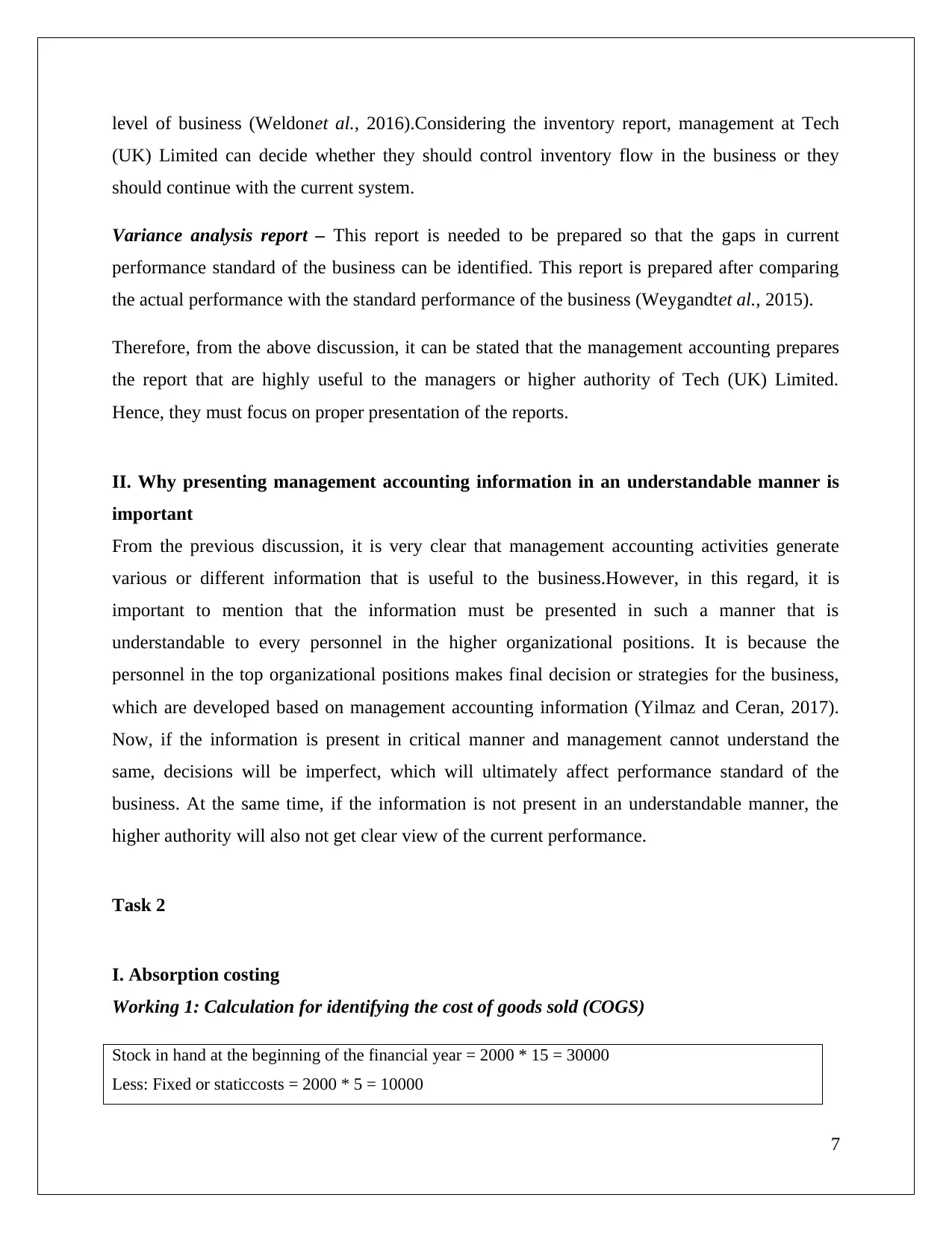
level of business (Weldonet al., 2016).Considering the inventory report, management at Tech
(UK) Limited can decide whether they should control inventory flow in the business or they
should continue with the current system.
Variance analysis report – This report is needed to be prepared so that the gaps in current
performance standard of the business can be identified. This report is prepared after comparing
the actual performance with the standard performance of the business (Weygandtet al., 2015).
Therefore, from the above discussion, it can be stated that the management accounting prepares
the report that are highly useful to the managers or higher authority of Tech (UK) Limited.
Hence, they must focus on proper presentation of the reports.
II. Why presenting management accounting information in an understandable manner is
important
From the previous discussion, it is very clear that management accounting activities generate
various or different information that is useful to the business.However, in this regard, it is
important to mention that the information must be presented in such a manner that is
understandable to every personnel in the higher organizational positions. It is because the
personnel in the top organizational positions makes final decision or strategies for the business,
which are developed based on management accounting information (Yilmaz and Ceran, 2017).
Now, if the information is present in critical manner and management cannot understand the
same, decisions will be imperfect, which will ultimately affect performance standard of the
business. At the same time, if the information is not present in an understandable manner, the
higher authority will also not get clear view of the current performance.
Task 2
I. Absorption costing
Working 1: Calculation for identifying the cost of goods sold (COGS)
Stock in hand at the beginning of the financial year = 2000 * 15 = 30000
Less: Fixed or staticcosts = 2000 * 5 = 10000
7
(UK) Limited can decide whether they should control inventory flow in the business or they
should continue with the current system.
Variance analysis report – This report is needed to be prepared so that the gaps in current
performance standard of the business can be identified. This report is prepared after comparing
the actual performance with the standard performance of the business (Weygandtet al., 2015).
Therefore, from the above discussion, it can be stated that the management accounting prepares
the report that are highly useful to the managers or higher authority of Tech (UK) Limited.
Hence, they must focus on proper presentation of the reports.
II. Why presenting management accounting information in an understandable manner is
important
From the previous discussion, it is very clear that management accounting activities generate
various or different information that is useful to the business.However, in this regard, it is
important to mention that the information must be presented in such a manner that is
understandable to every personnel in the higher organizational positions. It is because the
personnel in the top organizational positions makes final decision or strategies for the business,
which are developed based on management accounting information (Yilmaz and Ceran, 2017).
Now, if the information is present in critical manner and management cannot understand the
same, decisions will be imperfect, which will ultimately affect performance standard of the
business. At the same time, if the information is not present in an understandable manner, the
higher authority will also not get clear view of the current performance.
Task 2
I. Absorption costing
Working 1: Calculation for identifying the cost of goods sold (COGS)
Stock in hand at the beginning of the financial year = 2000 * 15 = 30000
Less: Fixed or staticcosts = 2000 * 5 = 10000
7
Paraphrase This Document
Need a fresh take? Get an instant paraphrase of this document with our AI Paraphraser
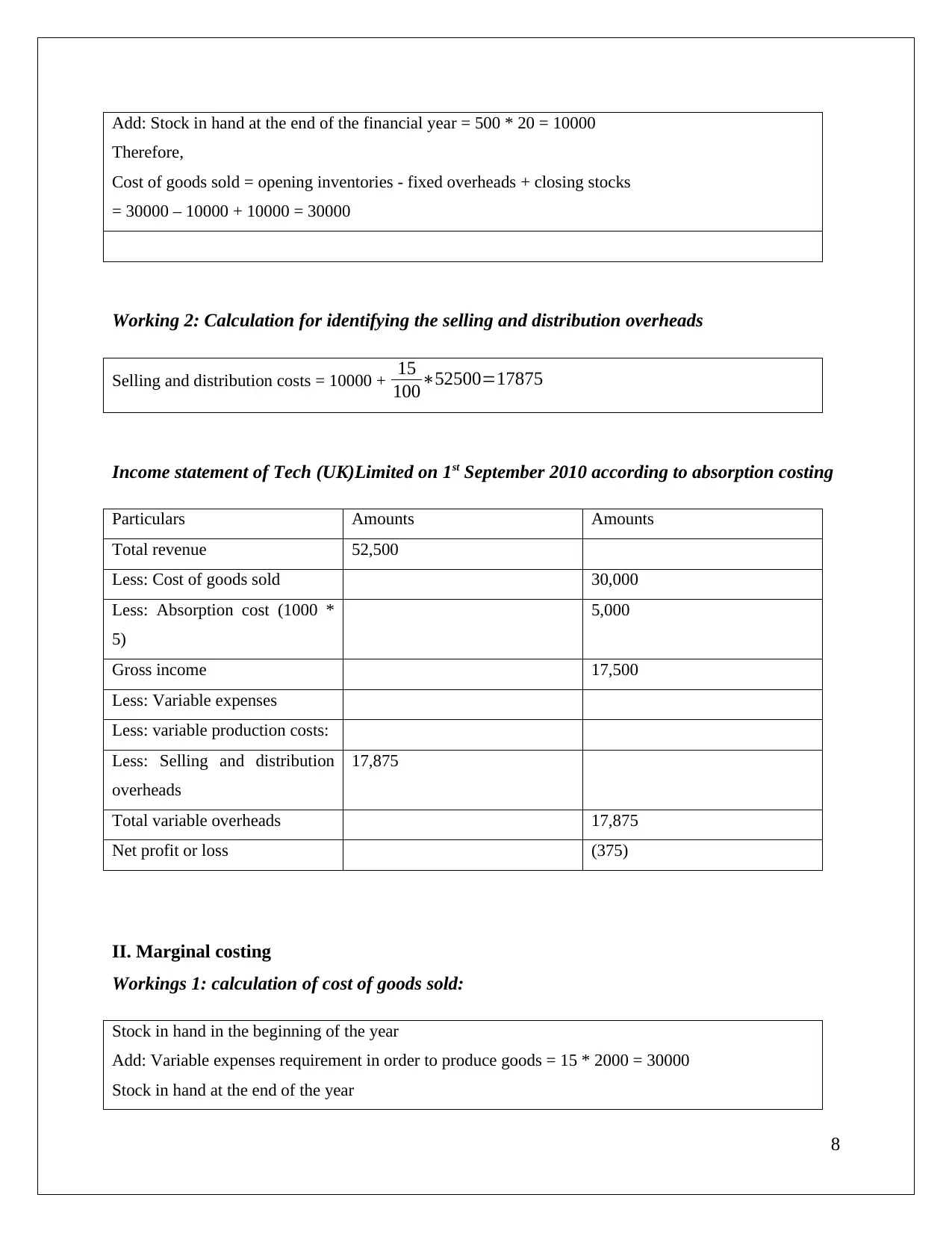
Add: Stock in hand at the end of the financial year = 500 * 20 = 10000
Therefore,
Cost of goods sold = opening inventories - fixed overheads + closing stocks
= 30000 – 10000 + 10000 = 30000
Working 2: Calculation for identifying the selling and distribution overheads
Selling and distribution costs = 10000 + 15
100∗52500=17875
Income statement of Tech (UK)Limited on 1st September 2010 according to absorption costing
Particulars Amounts Amounts
Total revenue 52,500
Less: Cost of goods sold 30,000
Less: Absorption cost (1000 *
5)
5,000
Gross income 17,500
Less: Variable expenses
Less: variable production costs:
Less: Selling and distribution
overheads
17,875
Total variable overheads 17,875
Net profit or loss (375)
II. Marginal costing
Workings 1: calculation of cost of goods sold:
Stock in hand in the beginning of the year
Add: Variable expenses requirement in order to produce goods = 15 * 2000 = 30000
Stock in hand at the end of the year
8
Therefore,
Cost of goods sold = opening inventories - fixed overheads + closing stocks
= 30000 – 10000 + 10000 = 30000
Working 2: Calculation for identifying the selling and distribution overheads
Selling and distribution costs = 10000 + 15
100∗52500=17875
Income statement of Tech (UK)Limited on 1st September 2010 according to absorption costing
Particulars Amounts Amounts
Total revenue 52,500
Less: Cost of goods sold 30,000
Less: Absorption cost (1000 *
5)
5,000
Gross income 17,500
Less: Variable expenses
Less: variable production costs:
Less: Selling and distribution
overheads
17,875
Total variable overheads 17,875
Net profit or loss (375)
II. Marginal costing
Workings 1: calculation of cost of goods sold:
Stock in hand in the beginning of the year
Add: Variable expenses requirement in order to produce goods = 15 * 2000 = 30000
Stock in hand at the end of the year
8
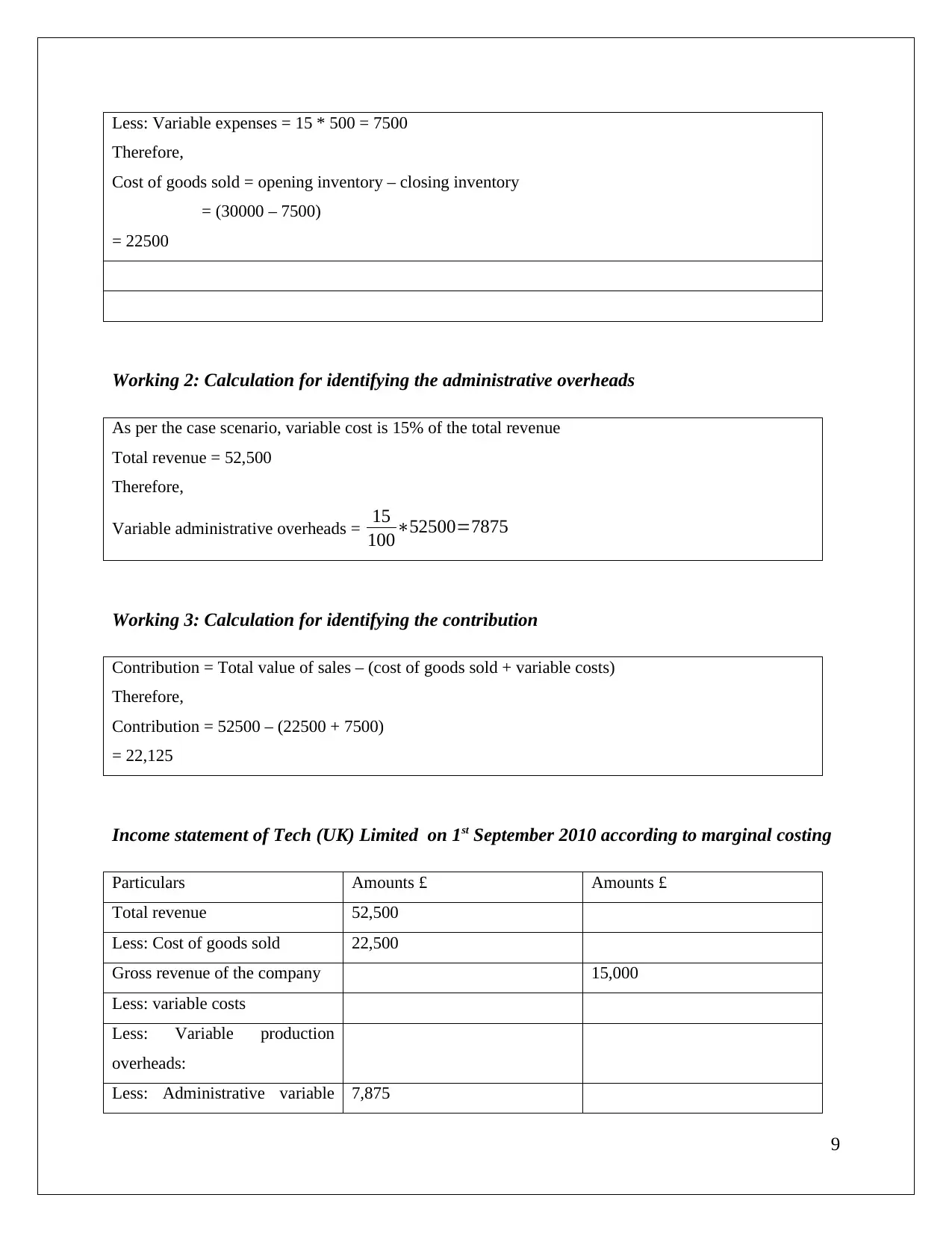
Less: Variable expenses = 15 * 500 = 7500
Therefore,
Cost of goods sold = opening inventory – closing inventory
= (30000 – 7500)
= 22500
Working 2: Calculation for identifying the administrative overheads
As per the case scenario, variable cost is 15% of the total revenue
Total revenue = 52,500
Therefore,
Variable administrative overheads = 15
100∗52500=7875
Working 3: Calculation for identifying the contribution
Contribution = Total value of sales – (cost of goods sold + variable costs)
Therefore,
Contribution = 52500 – (22500 + 7500)
= 22,125
Income statement of Tech (UK) Limited on 1st September 2010 according to marginal costing
Particulars Amounts £ Amounts £
Total revenue 52,500
Less: Cost of goods sold 22,500
Gross revenue of the company 15,000
Less: variable costs
Less: Variable production
overheads:
Less: Administrative variable 7,875
9
Therefore,
Cost of goods sold = opening inventory – closing inventory
= (30000 – 7500)
= 22500
Working 2: Calculation for identifying the administrative overheads
As per the case scenario, variable cost is 15% of the total revenue
Total revenue = 52,500
Therefore,
Variable administrative overheads = 15
100∗52500=7875
Working 3: Calculation for identifying the contribution
Contribution = Total value of sales – (cost of goods sold + variable costs)
Therefore,
Contribution = 52500 – (22500 + 7500)
= 22,125
Income statement of Tech (UK) Limited on 1st September 2010 according to marginal costing
Particulars Amounts £ Amounts £
Total revenue 52,500
Less: Cost of goods sold 22,500
Gross revenue of the company 15,000
Less: variable costs
Less: Variable production
overheads:
Less: Administrative variable 7,875
9
⊘ This is a preview!⊘
Do you want full access?
Subscribe today to unlock all pages.

Trusted by 1+ million students worldwide
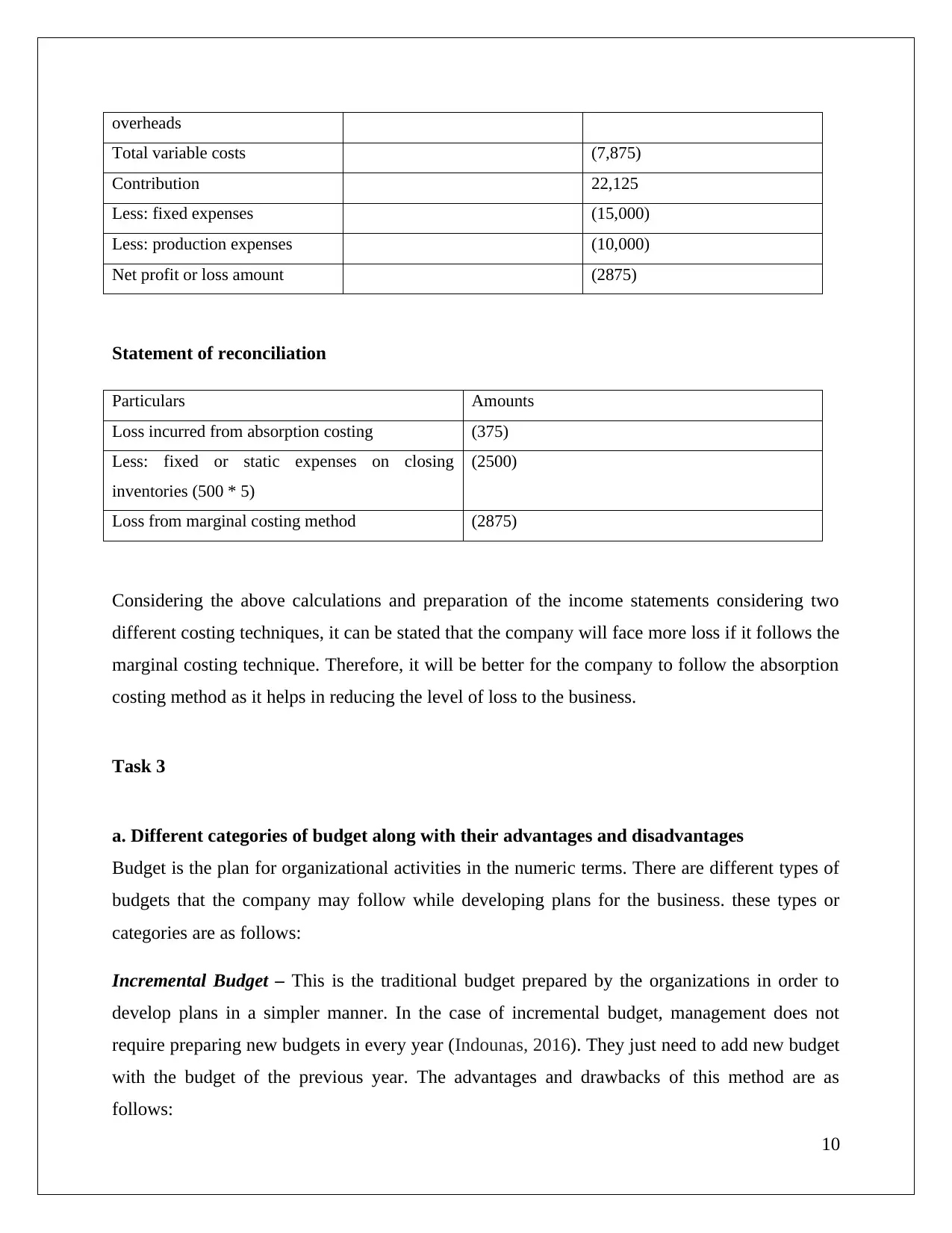
overheads
Total variable costs (7,875)
Contribution 22,125
Less: fixed expenses (15,000)
Less: production expenses (10,000)
Net profit or loss amount (2875)
Statement of reconciliation
Particulars Amounts
Loss incurred from absorption costing (375)
Less: fixed or static expenses on closing
inventories (500 * 5)
(2500)
Loss from marginal costing method (2875)
Considering the above calculations and preparation of the income statements considering two
different costing techniques, it can be stated that the company will face more loss if it follows the
marginal costing technique. Therefore, it will be better for the company to follow the absorption
costing method as it helps in reducing the level of loss to the business.
Task 3
a. Different categories of budget along with their advantages and disadvantages
Budget is the plan for organizational activities in the numeric terms. There are different types of
budgets that the company may follow while developing plans for the business. these types or
categories are as follows:
Incremental Budget – This is the traditional budget prepared by the organizations in order to
develop plans in a simpler manner. In the case of incremental budget, management does not
require preparing new budgets in every year (Indounas, 2016). They just need to add new budget
with the budget of the previous year. The advantages and drawbacks of this method are as
follows:
10
Total variable costs (7,875)
Contribution 22,125
Less: fixed expenses (15,000)
Less: production expenses (10,000)
Net profit or loss amount (2875)
Statement of reconciliation
Particulars Amounts
Loss incurred from absorption costing (375)
Less: fixed or static expenses on closing
inventories (500 * 5)
(2500)
Loss from marginal costing method (2875)
Considering the above calculations and preparation of the income statements considering two
different costing techniques, it can be stated that the company will face more loss if it follows the
marginal costing technique. Therefore, it will be better for the company to follow the absorption
costing method as it helps in reducing the level of loss to the business.
Task 3
a. Different categories of budget along with their advantages and disadvantages
Budget is the plan for organizational activities in the numeric terms. There are different types of
budgets that the company may follow while developing plans for the business. these types or
categories are as follows:
Incremental Budget – This is the traditional budget prepared by the organizations in order to
develop plans in a simpler manner. In the case of incremental budget, management does not
require preparing new budgets in every year (Indounas, 2016). They just need to add new budget
with the budget of the previous year. The advantages and drawbacks of this method are as
follows:
10
Paraphrase This Document
Need a fresh take? Get an instant paraphrase of this document with our AI Paraphraser
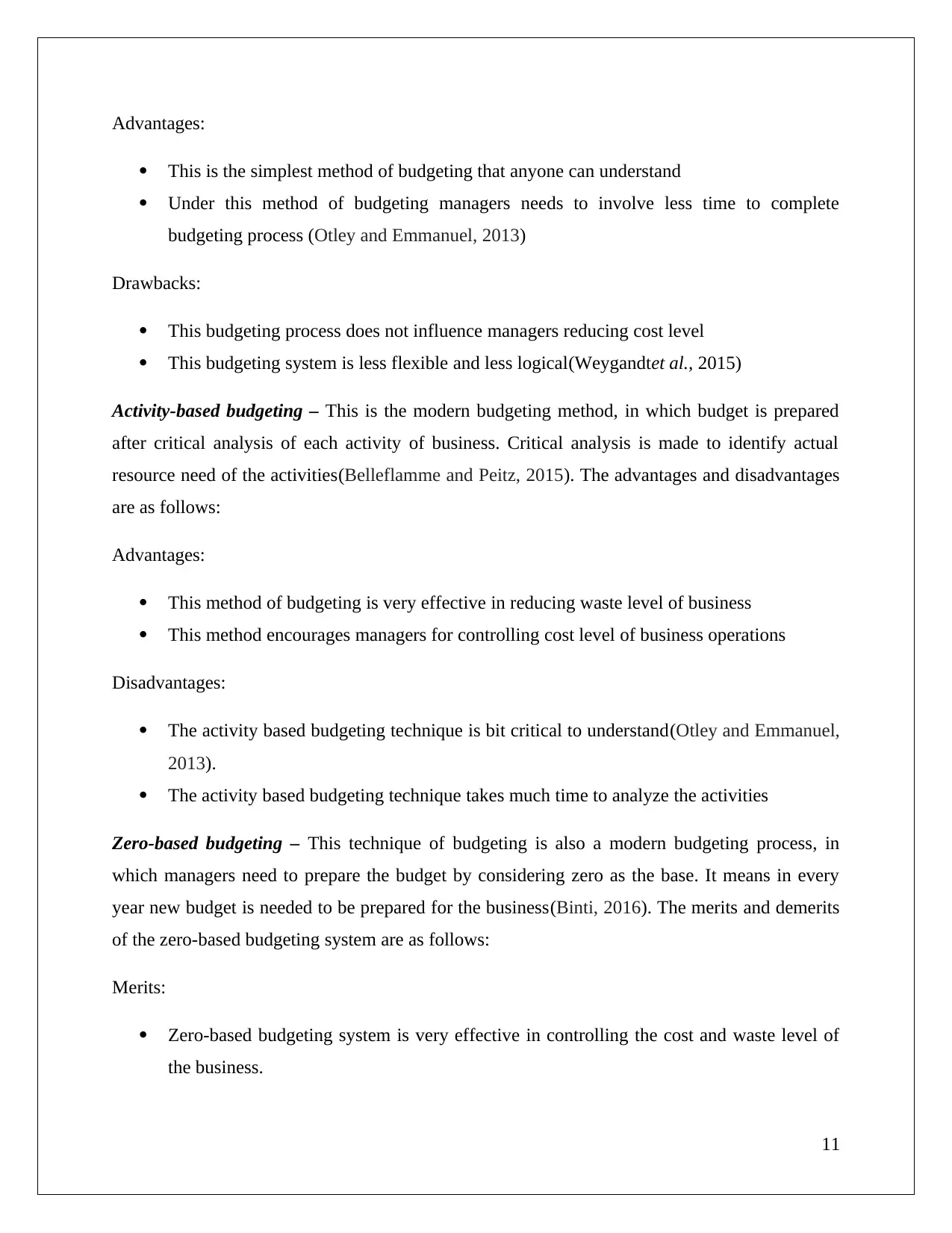
Advantages:
This is the simplest method of budgeting that anyone can understand
Under this method of budgeting managers needs to involve less time to complete
budgeting process (Otley and Emmanuel, 2013)
Drawbacks:
This budgeting process does not influence managers reducing cost level
This budgeting system is less flexible and less logical(Weygandtet al., 2015)
Activity-based budgeting – This is the modern budgeting method, in which budget is prepared
after critical analysis of each activity of business. Critical analysis is made to identify actual
resource need of the activities(Belleflamme and Peitz, 2015). The advantages and disadvantages
are as follows:
Advantages:
This method of budgeting is very effective in reducing waste level of business
This method encourages managers for controlling cost level of business operations
Disadvantages:
The activity based budgeting technique is bit critical to understand(Otley and Emmanuel,
2013).
The activity based budgeting technique takes much time to analyze the activities
Zero-based budgeting – This technique of budgeting is also a modern budgeting process, in
which managers need to prepare the budget by considering zero as the base. It means in every
year new budget is needed to be prepared for the business(Binti, 2016). The merits and demerits
of the zero-based budgeting system are as follows:
Merits:
Zero-based budgeting system is very effective in controlling the cost and waste level of
the business.
11
This is the simplest method of budgeting that anyone can understand
Under this method of budgeting managers needs to involve less time to complete
budgeting process (Otley and Emmanuel, 2013)
Drawbacks:
This budgeting process does not influence managers reducing cost level
This budgeting system is less flexible and less logical(Weygandtet al., 2015)
Activity-based budgeting – This is the modern budgeting method, in which budget is prepared
after critical analysis of each activity of business. Critical analysis is made to identify actual
resource need of the activities(Belleflamme and Peitz, 2015). The advantages and disadvantages
are as follows:
Advantages:
This method of budgeting is very effective in reducing waste level of business
This method encourages managers for controlling cost level of business operations
Disadvantages:
The activity based budgeting technique is bit critical to understand(Otley and Emmanuel,
2013).
The activity based budgeting technique takes much time to analyze the activities
Zero-based budgeting – This technique of budgeting is also a modern budgeting process, in
which managers need to prepare the budget by considering zero as the base. It means in every
year new budget is needed to be prepared for the business(Binti, 2016). The merits and demerits
of the zero-based budgeting system are as follows:
Merits:
Zero-based budgeting system is very effective in controlling the cost and waste level of
the business.
11
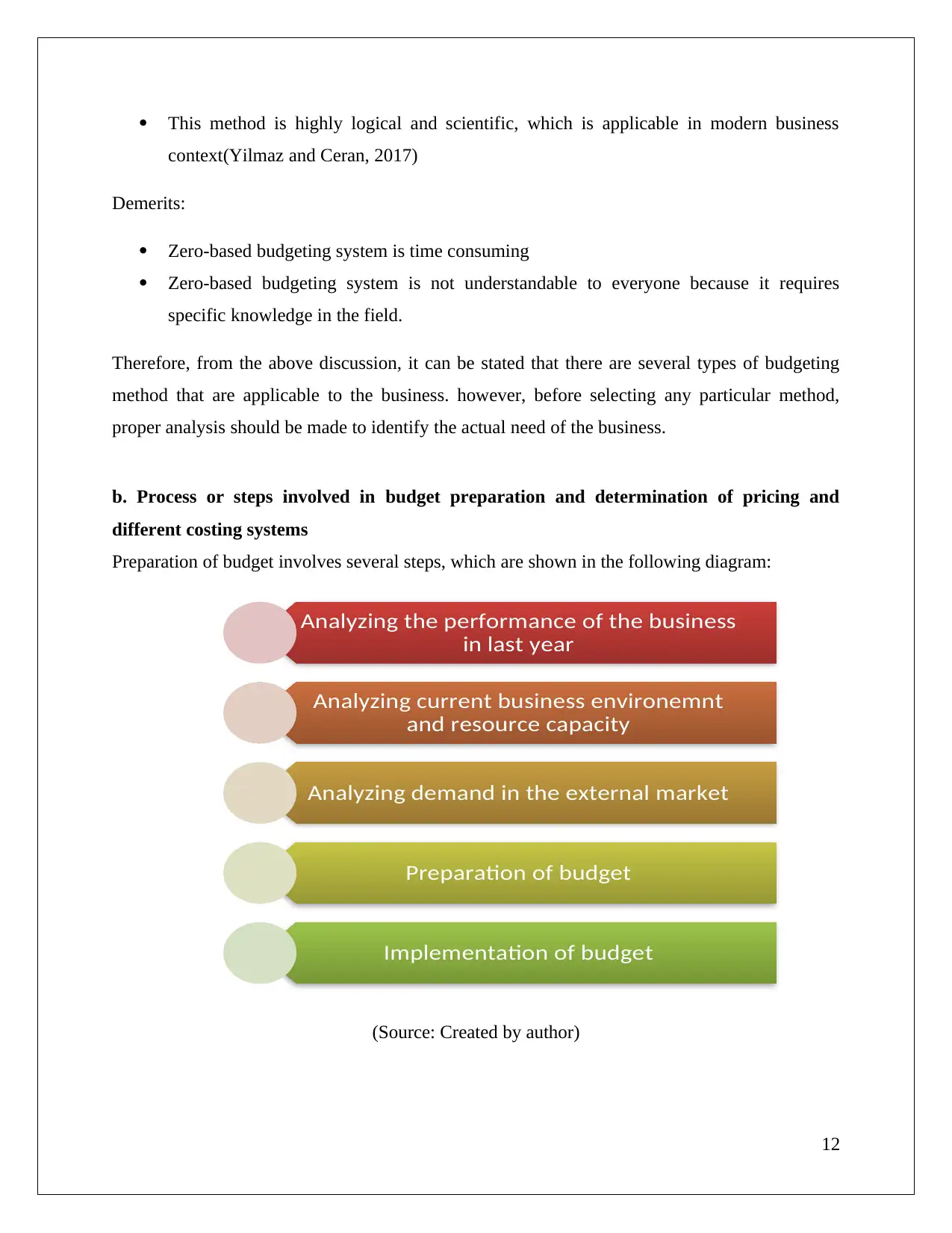
This method is highly logical and scientific, which is applicable in modern business
context(Yilmaz and Ceran, 2017)
Demerits:
Zero-based budgeting system is time consuming
Zero-based budgeting system is not understandable to everyone because it requires
specific knowledge in the field.
Therefore, from the above discussion, it can be stated that there are several types of budgeting
method that are applicable to the business. however, before selecting any particular method,
proper analysis should be made to identify the actual need of the business.
b. Process or steps involved in budget preparation and determination of pricing and
different costing systems
Preparation of budget involves several steps, which are shown in the following diagram:
(Source: Created by author)
12
Analyzing the performance of the business
in last year
Analyzing current business environemnt
and resource capacity
Analyzing demand in the external market
Preparation of budget
Implementation of budget
context(Yilmaz and Ceran, 2017)
Demerits:
Zero-based budgeting system is time consuming
Zero-based budgeting system is not understandable to everyone because it requires
specific knowledge in the field.
Therefore, from the above discussion, it can be stated that there are several types of budgeting
method that are applicable to the business. however, before selecting any particular method,
proper analysis should be made to identify the actual need of the business.
b. Process or steps involved in budget preparation and determination of pricing and
different costing systems
Preparation of budget involves several steps, which are shown in the following diagram:
(Source: Created by author)
12
Analyzing the performance of the business
in last year
Analyzing current business environemnt
and resource capacity
Analyzing demand in the external market
Preparation of budget
Implementation of budget
⊘ This is a preview!⊘
Do you want full access?
Subscribe today to unlock all pages.

Trusted by 1+ million students worldwide
1 out of 23
Related Documents
Your All-in-One AI-Powered Toolkit for Academic Success.
+13062052269
info@desklib.com
Available 24*7 on WhatsApp / Email
![[object Object]](/_next/static/media/star-bottom.7253800d.svg)
Unlock your academic potential
Copyright © 2020–2025 A2Z Services. All Rights Reserved. Developed and managed by ZUCOL.





